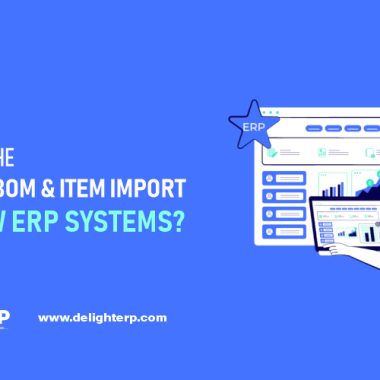Introduction Bill Of Materials (BOM)
Manufacturing industries need various materials for the production of the products. The companies use the Bill Of Material (BOM) to keep the list of all the materials.
The Bill Of Materials (BOM) always appeared in hierarchical formats with the finished products. There is a different type of Bill Of Material which is used by the companies or businesses. The list of the material is companies noted in the BOM.
Manufacturing Industries or companies have a goal to increase their profits. The businesses have to minimize their production cost for increasing their profits because of that, the companies used the bill of materials to keep the record of the materials.
A perfect and well-maintained BOM helps the companies for purchasing the raw materials, figure out the material cost, maintain inventory control, track the materials, keep the real-time records, decrease supply chain cost and minimize the wastage of the raw materials.
Structure of Bill Of Materials (BOM)
The companies are identified by the structure of the BOM. Below points are included in the bill of materials.
– Quality of products
In the bill of materials, the manufacturing industries include the quality of the products. Quantity of the products is necessary for the BOM through these companies able to figure out the number of the part is produced or manufactured.
– Measurement
In the bill of a material describe the unit of measurement for each quantity. For Example, length, inches, grams, square feet, cubic feet, etc.
– Level of BOM
Manufacturing industries give the number of the parts which helps the companies to easily select the part and use one by one product for the productions. There are two ways to figure out the level of BOM.
A. Single-level BOM
This is the simplest way to manufacture the products and a simple list of the products which are going to be used in the productions. This BOM represents the products used only at one time during the production. The single-level bill of material is not used for the complex production process because it does not specify the parent and child parts between the products or parts.
B. Multi-level BOM
The multilevel bill of material is complex but this offers the greatest details. The manufacturer can handle the complex production with the help of the multi-level BOM. This type of level of BOM reflects the parent-child relationship between the products.
– Part Name
Every part of the product is identified with a unique name. In the BOM there are specified the name of every product. Through which the companies easily identified the parts.
– Raw Material
Through the BOM the companies know about the current raw material so, there is a lack of chances to waste the raw materials.
– Images
The image of the products with every part gives the visual effect in the BOM. It helps the workers or employees to get the details with the image of the products.
– Notes
The industries do not down the particular or important notes for the part of the products. These notes help when employees are going to use the products.
– Product getting methods
Sometimes the industries purchased the products internally or externally that’s why they have to be mentioned in the bill of materials.
Also Read: What Is Production, Planning, Quality And Control?
Tips for creating Bill Of Materials (BOM) Structure
Here are some steps for creating the BOM through which the companies or businesses easily create the bill of materials.
1. Decided what the need of the Bill Of Materials (BOM)
A BOM has several types, that’s why the companies have to know that the BOM is specially made for the engineers, designers, their partners, or workers. Then the industries are aware that their production process is easy or complicated. The bill of materials is useful for companies or businesses and the perfect BOM is to give a chance to companies to increase their profits.
2. Which type of Bill Of Materials
The BOM has various types and levels so companies have to be clear about the need. Here are various types of bills of materials…
A. Manufacturing bill of materials
The manufacturing bill of materials is used when the industries need to specify that all parts are required to manufacture the products. The MBOM also includes the parts which are required for the production before starting the manufacturing processes.
There are several types of manufacturing bills of materials that are used by the manufacturing industries like, Enterprise Resource Planning(ERP), Material Resource Planning(MRP), and Manufacturing Execution Systems(MES), etc.
B. Engineering bill of materials
The Engineering Bill of Materials is designed during the part of the product design or computer-aided design(CAD). This EBOM includes the list of materials which is used for the engineers who design the part, which is used for the final products. This is possible, more than one EBOMs is associated with the one manufacturing products.
C. Sales bill of materials
The Sales Bill Of Materials is not like other BOM(Bill Of Materials). In the SBOM is listed the details of finished products before they are assembled for the sales phase. The SBOM provides the separate details of components and finished products in the sales order documents. Parents’ materials are listed as a sales item, not an inventory item and the Child materials are listed as sub-items.
D. Configured bill of materials
The machine manufacturers or industries used the Configured Bill of Materials. The CBOM listed all the components or materials which are required for the production of the machines as per the consumer’s specific requirements.
E. Service bill of materials
The service Bill of Materials includes all the needed parts, installation steps, and repair insurance techniques when the products are installed onsite at the customer’s place. The SBOM was designed by the engineers.
The businesses or industries simply select the type of materials from the above BOMs to fulfill their needs and provide the best service on time.
3. How many levels BOM includes
After selecting the type of BOM, manufacturers need to select the level of the bill of materials. The production process is simple and all the parts or materials are used at a time then the Single-Level BOM is selected by the companies.
But, the production processes are complicated and the materials are parent and child materials or more than one time a single product is used for the production then the businesses select the multi-level BOM for their companies.
4. Include needed information
The BOMs are usually designed for removing complexity. The companies carefully developed their bill of materials as per their need and remove or decrease the complexity of the productions. Manufacturers or businesses smartly developed the multi-level BOM through which they can easily complete their production processes.
Recommended for you: Product Costing And Pricing Made Better With ERP
Benefits of Bill Of Materials (BOM)
1. Purchasing the raw materials
The companies or manufacturers use the BOM to monitor the raw materials and other assembly parts which are used for the production of the materials. Through the bill of materials, businesses purchased the required materials with the required quantity for the completion of the production process and delivered them to the customers on time.
2. Cost of manufacturing the products
The manufacturing industries have to be aware of the cost of the production process to decide the price of the products, which will be going to sell in the market. The costs make an impact on the finished products’ prices and profits. Through the help of the BOM, industries have easily calculated the cost.
3. Inventory controls
The company can take control of the inventory through the bill of materials. That means reducing the cost and maximizing the profits by inventory control.
4. Improvement in the production processes
To become a successful manufacturing industry then they have to improve their production processes. The BOM through the businesses can provide the products on time and build a good impact on the consumers.
5. Waste Reduction
The manufacturing industries or organizations are using the BOM for the reduced wastage of the raw materials and the production parts. The companies reduced the wastage then they were able to minimize the cost of a manufacturing product and the profit margin of the products is increased. When the companies’ increase the profit margin then the companies increase their profits too.
Conclusion
The Bill Of Materials (BOM) is usually the list of the materials or the parts, which will be used for the finished manufacturing products. Sometimes the manufacturing industries or companies get in trouble by managing the production parts and several times the businesses increase the cost or wastage of the materials. That’s why the Bill of Materials helped the manufacturer to maintain their production parts and decreased the wastage of the materials.



